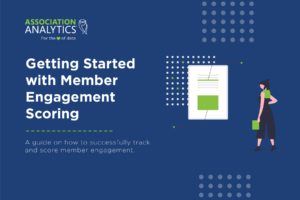As 2024 kicks off and the world of data and AI continues to rapidly evolve, associations need to adapt to meet the ever-changing needs of members and stakeholders. While these changes may feel overwhelming, there are easy things you can do with your current staff and set of resources that will help position your association to thrive in 2024. In this blog, we’ll outline our top three strategies to elevate your impact this year, along with ways to make small, easy changes that lead to large, impactful results.
1. Collect the right kind of data on your members
Talk to most association executives and they’ll tell you that their data is not in the best place. They may focus on data they feel is missing, or the fact that their association’s data is dirty and disorganized. Ask those same association executives what they’re doing to try to solve their data issues and they’ll likely say they have a staff member dedicated to cleaning things up, but it’s a constant moving target.
There’s no question about it: Data collection can feel overwhelming and scary, and it can often feel like a challenge you’ll never be able to overcome.
There’s got to be a better way, and we’d argue that there is! It’s time for your association to take advantage of the Fresh Start Effect. As we move into the new year, all this takes is a commitment to each other to make a fresh start when it comes to data governance and data quality.
This is an approach you can take pretty easily with the systems, tools and staff you already have in place. At the same time, these simple steps can help to make a big impact on your opinions of data collection quality and how those data collection and quality issues affect your ability to make data-informed decisions.
So how do you make a Fresh Start?
- Be deliberate – If you can’t tell members what you’re going to do with the answer they’re giving you, don’t ask those questions.
- Be consistent – If you ask the same type of question regularly, using control questions that allow you to compare how you’re doing over time that apply across the departments.
- Make it easy – Don’t put unnecessary barriers in front of members like having different departments ask members the same question, multiple times.
- Be creative – Make it fun for members by offering them an experience they want to participate in or a benefit they want in exchange for the data they’re giving you. For instance, at an event recently, the speaker offered to give his book away for free to anyone who sent him a text with their contact information. Those attendees willingly shared their information thanks to a unique ask and compelling offer.
There are a couple of different ways you can approach the collection of data but to start you’ll want to do a data collection audit. A data audit doesn’t need to be a huge scary undertaking, we’re simply talking about taking a look at your goals. You’re collecting data because you want to make decisions based on it, so it’s important to work backwards from the types of questions you want to answer to how you can collect the data you need. Here are a couple of key ways to gather the data, once you know what you’re looking for and why you want it.
Observe to learn members’ preferences and interest
You likely have data on the purchases your members are making, the events they’re registering for and the content they’re downloading. This is considered an
implicit data collection method. Observing is the most valuable type of data. Often, your incomplete, dirty or old data can be adjusted through observation and without disturbing your members from their experiences. You should be able to observe data points that help to fill in gaps such as years in the profession, years as a member, and member types.
Your members are also typically really bad at self-identifying with what they actually want due to confirmation bias. For instance, Amazon doesn’t ask customers for behavioral data. They simply observe what customers are shopping for to help inform the products and services they see in the future, giving weight to things viewed or searched more often.
Ask for the data you want
If observed data is not available, this is your next best option. You’re probably already asking for this data on your application forms, in surveys and during event registration. This is considered an explicit data collection method.
As you think about the current methods you’re using to ask members questions, consider one question you could add to one of those forms that would return highly valuable data. If adding length to your survey or form is a concern you may also want to consider which questions you may be able to retire in 2024.
The thing to remember here is that it’s not about asking too many questions, it’s about asking the wrong questions the wrong way. Consider how you plan on using the info you’re asking for and how to collect that info in a way that’s consistent so that the data will be usable. Make sure you’re collecting data that rarely changes, data that every member has available and data that would be a reliable unique identifier for each member. The most valuable type of data is something that will make it easier for your association to educate and inform that member. Examples of this kind of data would be your members’ cell phone numbers. Those likely won’t change despite job changes and will allow you to engage with them (with the appropriate opt-ins).
2. Get more serious and practical about AI
Much of the work around AI these days is what we’d refer to as ad hoc. Your team members are likely using it in an experimental way. They’re trying it out for personal uses like planning vacations or menus.
If associations want to make a big impact with AI in 2024, there needs to be more of a focus on the institutionalized aspects of using AI, starting with officially recognizing and promoting effective ways to use AI regularly in our jobs. We’re not suggesting you go all-in or dive in blind. It’s important to incorporate in a smart and scalable way. There are massive benefits to using AI, but a policy that shapes how your team uses it is an important starting point.
Like cleaning up data, this can feel like a huge undertaking, but there are a few points to focus on to make it more doable. Start by identifying some key areas where you can make a big impact with AI and then, as with any sort of organizational adoption, identify a group of key people who can be responsible for spearheading the adoption of AI. These will likely be senior level people in your organization who will be responsible for crafting policy and encouraging participation. We’d also recommend that this team be a cross-functional one.
In order to be more efficient and effective, training should be organized and should offer guidance on the types of things your association is looking to do with AI tools. It should also involve an emphasis on data privacy and ethics. Read more about preparing your association’s data for AI in this recent blog.
AI can be used for brainstorming, content creation and ideation, event planning, content translations, data analysis, topic modeling, summary creation, and as chatbots or virtual assistants. With all these uses (and more!) documentation will come in handy. You’ll want to consider creating guides for the different types of AI uses you expect your team to be involved in. If you’re not sure where to start, we’d suggest looking to other organizations and forums for templates.
This kind of guide may also be something you consider developing for your members, as it’s likely they’re dipping their toes into the AI waters as well. The more resources you can provide them on how to navigate the uncertainty surrounding AI, the more they’ll continue to look to you as the trusted thought leader they can’t live without.
3. Create and communicate your value proposition
When your association loses members, do you know why? While some members retire or even simply just forget to renew, more often there’s an issue of relevance that we’d describe as lack of value clarity. This typically relates to your association’s value proposition in one of two ways. Either you don’t have very much value or you’re not communicating that value effectively.
Bonus tip: To catch members who just forget to renew, consider enrolling the,m into an auto renewal program. To make this more effective, add a checkbox to your renewal form to opt-out of auto-renewal instead of asking them to opt in. One of our A2 customers who tried this have seen a significant jump in renewal rates.
Your value proposition is the unique statement of the value an association offers to its members and it’s a promise of what you’re going to receive if you join. It should be clear and compelling and focus on the benefits that only members receive (learn more in this on-demand webinar). What would they notice tomorrow if their membership with your association went away? If you don’t know what those things are, it’s difficult to have a clearly defined value proposition, which means it’s especially difficult to recruit and retain members.

We call this the Engagement Model and it’s a great way to measure how your members (and non-members) interact with your all products and services. Using an engagement model, you can see how effectively you’re communicating your association’s value proposition and how it’s resonating with different segments of your audience. You can also use it to help inform changes you may want to make to improve your value.
Download our Getting Started with Member Engagement Scoring guide to learn more about this model and how to successfully track and score member engagement.
Making a fresh start in 2024
As we navigate the challenges and opportunities of 2024, associations have the chance to make a fresh start in redefining their role and significance in members’ lives.
By focusing on strategic data collection, embracing AI as a practical tool, and refining your value proposition, you have the opportunity, not only to stay relevant, but to become an influential force that shapes the future of your members and industry.
Dive deeper into these 3 strategies by watching this on-demand webinar.
See how AcumenAI can help you can make a bigger impact at your association by scheduling a quick demo.





